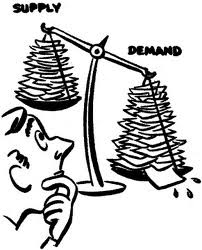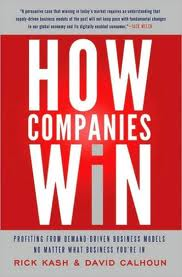The Rules are changing. As noted in How Companies Win – Prepare for A Demand-Driven Economy we’ve been moving from a supply-based to demand based economy.  The book How Companies Win: Profiting from Demand-Driven Business Models No Matter What Business You're In, by authors Rick Kash, David Calhoun examines this and my blog specifically provides an example from the book on how McDonalds has successfully negotiated this change already.
The book How Companies Win: Profiting from Demand-Driven Business Models No Matter What Business You're In, by authors Rick Kash, David Calhoun examines this and my blog specifically provides an example from the book on how McDonalds has successfully negotiated this change already.
There are several other examples in the book about a dog food company and Best Buy. These alone should open your eyes to the potential game-changing forces at work and how you can benefit from this opportunity. They are definitely worthy of picking up the book.
Strategic Discipline as coached by Positioning Systems is a critical element in attaining this Demand Driven change. It requires a constancy of feedback from employees and customers in order to determine with precision (as noted below in the six rules) in achieving alignment with what your customers want, and want you want to sell. In our weekly meeting rhythms the agenda demands that employee and customer feedback is included which provides for pattern recognition to help emerge and identify these precise opportunities.
Let me ask you a question the book asks: What do you know about the demand of your most profitable customers that your competitors don’t know?
This question is best broken down into four more focused questions:
- Who are my most profitable customers?
- What is their unsatisfied current, latent, and emerging demand?
- How do I differentiate my products and services so I better satisfy the demand of those most profitable customers?
- What is the action plan so I can align the people inside of my company to satisfy the demand for all of our customers outside of my company?
How do you accomplish this change from a supply-based organization to one that is demand based? It starts not by what you ask people to do, but rather how you ask them to think. If you want to change the way a company acts, you must first change the way its people think. And what should they start thinking about?
That requires a consistent approach to your management style, and is one reason why the Strategic Discipline for meeting rhythms is such a critical part to this change in your team’s thinking. Here (taken almost directly from the book) are their six rules to follow to change your business to Demand Based thinking.
- The Primacy of Demand. Demand is the new game changer.
 You can’t win anymore through great supply chain management alone; it remains necessary, but it is no longer sufficient. Today, almost every industry and category is in a significant oversupply situation, and any company that expects to maintain strong profitability and outpace its competitors must compete on demand. Demand now rules, and it will for years to come.
You can’t win anymore through great supply chain management alone; it remains necessary, but it is no longer sufficient. Today, almost every industry and category is in a significant oversupply situation, and any company that expects to maintain strong profitability and outpace its competitors must compete on demand. Demand now rules, and it will for years to come. - Adding the Fifth P: Precision. For forty years, most business students have been taught the four P’s of marketing: product, price, place, and promotion. To win in this new competitive environment we need to add one more P to the mix: precision. The greater the precision in analyzing demand, the tighter the alignment between what you want to sell and what the customer wants to buy.
- Innovation as a Science of Demand. In the demand economy, a spirit of innovation must now permeate the entire organization. It is “total innovation.” It is the best way for a company to identify new opportunities, marshal the talent and resources it will need to attack those opportunities, and restructure itself to quickly and effectively respond to newly discovered sources of demand. The best definition for successful innovation is to find unsatisfied profitable demand and fulfill it. And it won’t be just R&D developing new products either; now every department, from sales to service to manufacturing and marketing, will have to be part of the team, key players in the search for total innovation. (This is another reason why successful meeting rhythms are an integral part of identifying demand driven opportunities.)
- Developing a Clear Thesis for Winning. One of the key characteristics of successful companies is that most have a powerful thesis for how they will win in the marketplace that can be expressed in simple terms the entire organization can understand. While the thesis is typically built from in-depth analyses of demand, customers, competitors, the marketplace, core competencies, and other critical factors, it is ultimately simplified for the entire organization and its external partners to understand. McDonald’s has already given us an example.
- Building the Mental Model. It is not enough to simply express your company’s strategy for competing and winning against the competition. Rather, that strategy must be supported, endorsed, and believed in by the people inside the company. This is best accomplished with the creation of a clear statement of how the company will win, and then that statement must be promulgated through every part of the company until it becomes second nature to every employee. A successful Mental Model of how you will compete and win is shared throughout your organization.
- The Rise of the Demand Chain. It is possible to construct an apparatus on the demand side of your business that is similar in organization, sophistication, and power to the traditional supply chain. Such a demand chain is capable of assuming a natural place alongside the traditional supply chain to create what can be considered a new kind of integrated business model, one in which the demand chain will make the supply chain more targeted and efficient. Ultimately, this combination will have the kind of revolutionary impact last seen with supply chain management a half-century ago.
The authors note that the old rules will still apply—be the low-cost producer, hire the best people, continually innovate, understand your customers’ needs—but they are no longer enough. You must find a way to defeat the threat of that flat to downward demand curve, and do so in a way that enables you to build defenses against those multiplying competitive threats, both visible and yet to emerge.
What the authors discuss is the ability for your business to differentiate demand and capitalize on the opportunities for demand that your competitors are unable, unwilling or are to slow to respond to.
Will take a look at how you can benefit from this differentiated demand in our next blog.






.jpeg?width=150&height=135&name=Hand%20with%20marker%20writing%20the%20question%20Whats%20Next_%20(1).jpeg)

